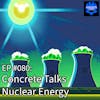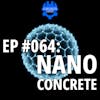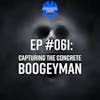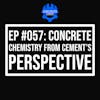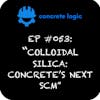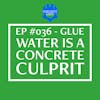EP #050: Polishing Concrete 101

Hey there, concrete enthusiasts! Are you ready to discover the untold secrets of polished concrete? Well, get ready for an eye-opening episode of the Concrete Logic Podcast, hosted by yours truly, Seth Tandett. In this captivating installment, I had the privilege of sitting down with none other than Tim Blankenship, a true legend in the concrete industry.
Imagine walking into a store and being captivated by the stunning floors beneath your feet. Have you ever wondered how they achieve that breathtaking finish? Prepare to be amazed as Tim, with his remarkable 37 years of experience, takes us on an exhilarating journey into the world of polished concrete.
But this podcast episode goes beyond the surface. We delve into the intricate details, from the crucial pre-construction meetings to the meticulous selection of diamond bonds for the perfect aggregate exposure. Tim fearlessly shares his challenges, and triumphs, and even reveals how polished concrete has revolutionized major retail giants like Home Depot and Walmart.
Whether you're a die-hard concrete enthusiast, an aspiring contractor, or simply intrigued by the captivating world of polished concrete, this episode is a must-listen! Join me on the Concrete Logic Podcast as we unravel the hidden techniques, artistry, and limitless possibilities behind achieving that envy-inducing shine. Trust me, this is an episode you won't want to miss! Episode References Guest: Tim Blankenship | Blankenship Concrete Polishing | tim@blankenshipconcrete.com Guest Website: https://www.linkedin.com/in/blankenshipconcrete
Producer: Jodi Tandett Become a Producer: https://concretelogicpodcast.com/show-support
Music: Mike Dunton | https://www.mikeduntonmusic.com | mikeduntonmusic@gmail.com | Instagram @Mike_Dunton Host: Seth Tandett, seth@concretelogicpodcast.com Host Website: concretelogicpodcast.com
Episode #050 Transcript
Seth (00:01.939)
And welcome to another episode of the Concrete Logic Podcast. And today I have Tim Blankenship with me today. He's going to talk about polished concrete. Tim, tell us a little bit about yourself.
Tim Blankenship (00:12.298)
Hey there. I've been in the concrete industry for the last 37 years. I've been on place and finish. I've been laser screen operator. I mean, warehouse manager, project manager. I've kind of worked one into the other, been self-employed for the last 10 or 12 years now, polishing concrete. So, I mean, I've...
Tim Blankenship (00:35.242)
feel like we had a good background for polishing. We've done industrial floors, high rises, super flats. So if it's in concrete, we've pretty much been around it or done it sometime or another. So, you know, ended up into the polished concrete, which I enjoy it. It's simple, but it's not, every floor is different and you get to be able to adjust to it. And our floors are only as good as what the concrete finishers give us.
Tim Blankenship (01:04.518)
So, you know, the floors start long time before we get on the job site. You know, we need to review mixed designs with the concrete contractors, make sure we have something that we can polish. Talking about the FF, FFLs, then going through how to finish the edges. Cause edges always seem to be a problem. Whereas a trial machine, riding trials get close and then they finish them by hand.
Tim Blankenship (01:30.238)
And then when we get to polish, it comes out to a different color because the density is different. So there's a lot of planning going up front for the polishing ever even starts. So.
Seth (01:40.953)
Yeah. Yeah. So Tim and I were talking briefly before we started and he made a very good point. He says concrete contractors typically they either do polishing concrete or how did you frame it Tim? Either do polishing concrete or you just do the regular stuff like I do.
Tim Blankenship (02:05.038)
Right. Most of the concrete contractors don't polish floors and most of the polishers don't finish concrete. So there's always a gap in between there what we need and what we get.
Seth (02:12.324)
Yeah. It's a, yeah, it's a specialty. You're, you're a specialist. Um, so yeah, we avoid that stuff big time. So we always exclude it as best as we can. Um, but like you mentioned, Tim, uh, being aware of where the polished concrete is on a job is, is very important.
Seth (02:35.603)
With any floor finish really when you're the concrete contractor because you want to make sure that you're setting setting up the next trade So that's what I'm hoping Tim's gonna help us with today so we can maybe we could start off with With Pre-planning so we've talked on this podcast several times Tim about the the pre-construction plan or the pre-port plan and
Seth (03:05.003)
getting everyone involved that's a stakeholder in the job. And I imagine, I can't think of one that I've had the polishing guy on the job, so I must have screwed something up. I might have screwed something up, Tim. But I would say you want to be a part of that meeting, wouldn't you?
Tim Blankenship (03:25.61)
Yes, pre-construction definitely want to be part of because there's so many moving parts for the floors. I mean, you got to think the floor is the finished product. So, you know, without planning ahead that we spend a lot of times doing schoolwork and I'd say 80% of the time we're repairing the floors before we even get started because during the construction or the edges didn't turn out right, expansion joints were loose from the walls. I mean...
Tim Blankenship (03:54.838)
Floor's not flat, so we end up with aggregate exposure in one place and none in the other. Occasionally find a footprint that finished or left behind. I mean, it's just walking on it, which you have to do, but there's just so many little variables that pop up. And again, when we get there, it's basically a blank canvas. So whatever they've done to it before we got there, we get to deal with afterwards. So, I mean, again, the pre-planning part is knowing you're gonna polish it and knowing it needs to be flat.
Tim Blankenship (04:24.374)
taking time to do the edges, even isolations, which you have to deal with them, but usually somebody either not edge them, they'll run over it and it'd be ragged or they'll go over the box itself and it has a tendency to crack. Now I have to go find it and dig it out. So it's just, we play a lot of mystery stuff here. Trying to figure out, we find drains and clean outs all the time. We're polishing a floor and you'll find a round circle.
Tim Blankenship (04:53.81)
in the floor where it cracked. OK, we now know something's under there. So we'll dig it out and fix it. And like I said, the polishing itself is anywhere from six to 10 steps. And it all comes down to the floors being different. And what we typically test a floor to start with is what they call Moles Pencil Test, is where you scratch it and try to figure out what bond to diamond. You're familiar with saw blades.
Tim Blankenship (05:22.462)
and how they have a hard bond for medium, for asphalt, and a soft bond for hard concrete, this and that. Yeah, well, we had the same thing we deal with, except for we end up dealing with five or six different bonds in different grits. I mean, at any given time, we can be toting $60,000 to $100,000 in diamonds just so that we roll up on a job that we're able to adapt to whatever we have going on to start polishing. So.
Seth (05:28.587)
Yeah, like diamond blades
Seth (05:50.509)
Yeah, so can you talk a little bit about the, maybe you're going to get to this, you said there's six or seven steps that you got to do. I guess first off, let's, for...
Seth (06:02.191)
for our listeners, let's tell them what the polished concrete is. It is, it's that shiny look, right? The shiny concrete floor that probably most people see when they walk into like a, I'm trying to think like a bank, like entrance of a bank or where else do you see polished concrete, um, that people would notice? Oh, there you go. Everybody goes there. You're right.
Tim Blankenship (06:21.582)
Actually, the two most common places you'll find it is Home Depot and Walmart. So, I mean, everybody goes to one or the other. So, and again, every floor is different. So that we have to adjust to it and use to expect to tell you, they tell you what grits. Now grit is a size diamond, which controls the aggregate exposure, whether you want large aggregate, medium or no aggregate. And that all comes, no, depends on.
Tim Blankenship (06:51.946)
what the architect and engineer are looking for. Very common, they have what they call a salt and pepper finish, which, let me back up. Concrete Polishing Council has set standards for, or try to set standards as far as polished concrete goes. And they determine the sheen level of what you get from, whether it being a flat finish, a medium, a high shine, or basically mirror-like shine.
Tim Blankenship (07:21.27)
Then they said aggregate exposure from a cream finish, which is just you hit it and you barely expose the sand, which is kind of what you get on new floors. It's really hard to get on old floors because again, if you're grinding glue off or you're removing mastic, you have to grind through it first. At that point, you're breaking the surface on it, which leads us to what the second step would be a salt and pepper, which is some fine aggregate, some large aggregate.
Tim Blankenship (07:51.71)
that comes down to how the floor is poured, how flat it is, determine the variable in your aggregate exposure. And then the last case is you've got a coarse aggregate, which you grind all the way down to the surface till you have full rock showing. So.
Seth (08:09.972)
So what are the Home Depots in the Walmarts? Which grade is that?
Tim Blankenship (08:13.518)
But when you go to Home Depot, they're basically ground to like a 400 degree. So it's got just a little bit of shine when you look at it, but not much. So you got some light reflectivity. Then when you go to Walmart, it seems to be common now, they have a high shine. You walk in the door and it has kind of a mirror look to it to start with. You kind of see a little bit of, you see some reflections from the aisles, the clothes, the lights reflect. So it's a higher reflectivity.
Tim Blankenship (08:43.038)
and clarity. And how you get there, again, I hate to keep repeating it, but every floor is different depending where you start. And we usually have three different types of diamonds that we run through the process. One being a metal bond, which is where you do the initial cutting. And it goes anything from a 16 grit, which is a very large diamond, the exposed aggregate, and cut the surface off, up to 120 grit, which is a very fine diamond. That way, you're barely exposing the sand on it.
Tim Blankenship (09:13.43)
Well, after we go through the metal bonds, which it could be, it could be one step, it could be three steps, depending on the floor itself and the aggregate exposure they're looking for. And then sometimes when you're looking for a full aggregate, we actually have bush hammers, just like you'd have on a jackhammer. But these hammers go on the bottom of the grinder, and they chew the top off and give you that same texture, just like a bush hammer does. At that point, then you'll go to a 30 grit diamond, and you'll start.
Tim Blankenship (09:42.23)
you'll cut the roughness off, and you've exposed your aggregate. So after we got that determined and back up, now all this happens on a sample typically. So the architect can say, yeah, I like it, or maybe let's do something different, which has been known to happen a time or two. But after the metal bonds, we get into running what they call a hybrid, which is maybe a mixture of ceramic resin and metals together. And what that does,
Seth (09:46.289)
the
Tim Blankenship (10:11.102)
is that will take the scratches out from the floor that you ran the metals. And it's a polishing, but you got to think the whole first four or five steps, you're really scratching the floor, trying to expose the sand, get the irregularities out of it and stuff like that. And the polishing does actually start till you get to like a 400 grit. And at that point, you'll always see the shine changes from, you know,
Tim Blankenship (10:38.89)
400 to an 800. All of a sudden, it's kind of shiny. You wonder what's going on. When you hit the next step with polishing the 800 grit, all of a sudden, you've got a reflection to it. Start to get real shiny. You clean it. You're thinking, that looks pretty good. But now, we also go to a 1500 grit, which increases the clarity on the floor. I mean, the shine doesn't change a whole lot, but the clarity does. So now.
Tim Blankenship (11:08.514)
The last step, we go to a 3000 grit diamond, which is very high. And at that point, you end up with mirror-like qualities to the floor. Now, with polishing, you also got to be somewhat of a chemist to do all this. You have densifiers that go in to harden the surface. You've got structural urethane grouts that go on the floor to fill pinholes and repair damages. Then they have what they call a guard, which is kind of like an acrylic sealer semi-penetrating.
Tim Blankenship (11:37.174)
And then after that, they have full penetrating sealers that go in for oil, water repellency, and stuff like that. So when you put a system together, I mean, it's going all the way from what we're gonna start with grinding to what chemicals we're gonna use, how much repair work, and what all's entailed with it. Usually the first step, which I forgot, is that you've cleaned and filled your joints, your saw cuts.
Tim Blankenship (12:03.854)
And again, they either get an epoxy joint filler or a two-part polyurea joint filler. And you do that first because as you start grinding, the diamonds have a tendency to grab the edge of your joints and either scratch or sometimes when you soft cut, you know, you'll get a little bit of raveling to your joints. Well, the diamonds can make that worse by taking a raveled joint already and extending it a little bit. So.
Tim Blankenship (12:31.946)
It's again, it's going in here and reading your floor to start with and seeing how you're going to start, how you're going to address it. If you're going to expose the aggregate in your floor, you really want to fill your joints first. So as you cut it down, you don't break the edges off. So, again, on our part, we do a lot of concrete repair work too. So when we run across the broken edges, all of a sudden we're taking urethane mortars and stuff like this. We're trying to match colors to get the floor as close as we can.
Tim Blankenship (13:02.194)
So, I mean, polishing concrete is actually a lot more than just pushing the machine around. So.
Seth (13:08.682)
the
Seth (13:09.219)
Sounds like it. It sounds like a lot of work. You don't make it sound appealing, Tim. It sounds like a lot of hard work. But let's, so the reason why owners want polished concrete, I assume it's easier to maintain and also maybe reflective of light and stuff. Is that why they polish concrete?
Tim Blankenship (13:34.258)
Yes, you think average owners, before polished concrete, they were in a VCT or tile. So they're always scrubbing the floors, they're cleaning them, they're waxing them. After a few more times in there, stripping the wax off, redoing it. And over the years, I've seen typical maintenance costs for, let's say, a VCT floor. Runs about $1 to $1.25 a square foot per year. Well, that adds up to be a lot of money.
Seth (14:00.406)
the
Tim Blankenship (14:02.306)
Think Home Depot is 130,000, 150,000 square feet. So that's just maintenance cost. The maintenance for polished concrete is typically dry. It's a dust mopping, scrubbing. There's no wax, no sealers. There's nothing to strip and redo. Maintenance costs on the polished concrete, depending on your traffic, typically runs anywhere from $0.20 to $0.35 a foot.
Seth (14:09.743)
Yeah. Oh, that's cool.
Tim Blankenship (14:32.042)
So you got almost a dollar a foot savings. A lot of school systems are going to polished concrete for that very reason. You think one school system could have a million, a million and a half square feet over multiple schools. All of a sudden, they're saving a dollar a foot in maintenance. Or Walmart have what, 30 million square feet across the country or something? So yeah. I mean, it just.
Seth (14:51.03)
the
Seth (14:57.567)
some crazy like that yeah
Tim Blankenship (15:01.414)
That's the biggest thing is that some people like the aesthetic looks. They like the shine. It has a clean look to it. A lot of warehouses are going to polish concrete, A, for maintenance, and B, with the reflection, they're able to tone down the light some. I mean, you're using less lights for the same amount that you would if it wasn't polished. I mean, the reflectivity adds a lot to the floors. Years ago, it did some white reflective floors.
Tim Blankenship (15:31.358)
and put the white color hardener on the floor's warehouse. And it just made the total difference night and day from a white floor versus a standard gray floor. Then when you add polishing on top of that, it's just a huge difference in light reflectivity. And they say that, no, I've read several times that where the light reflectivity is better, where you have better lighting, employees have a better attitude. They work.
Tim Blankenship (16:00.874)
It just phases everything all the way around. I guess the psychological effect to it too. You're in a clean, bright warehouse instead of a dungeon.
Seth (16:11.201)
Yeah, make life a little bit better. Huh, that's cool. And we hit on it a little bit. The so.
Seth (16:23.447)
Yeah Most do I'm curious when you when you're doing a Home Depot or a Walmart do they have a pre con pre poor meeting? Oh, okay. It's okay. That's good to hear Yeah Yeah
Tim Blankenship (16:33.514)
Oh yeah, when you get into the big box stores, I mean, you'll end up having the engineers, architects, contractors, and everybody there. Now, when you get into the smaller stores and the schools and systems like that, which, you know, they'll have a pre-pour, but usually they won't invite the concrete polisher because they're taking the concrete guy. Or when you get there, the last pre-construction meeting I went to, actually we had the pump guy, the ready mix, everybody but the concrete guy.
Tim Blankenship (17:03.254)
So it's like, OK, we'll talk. I don't know what good it's going to do. And at that point in time, concrete guy comes in, does what he does, and we deal with it after the fact. So the biggest thing is, for anybody who is planning polished concrete, is to remember we can only give you what you give us. I mean, again, if you give us a floor with ups and downs in it, ridges.
Seth (17:07.113)
Right. Right.
Tim Blankenship (17:31.954)
unfinished edges per se, or when your column isolations don't match, A, because they took the sidewalk mix and poured in there just as what concrete they had that day, they decided to fill it in with, or as much people would hate it, if when you're finishing column isolations, you actually need to finish them out with like an eight inch stair trowel. That way you can put the pressure on it and get it to somewhat match the floor you're turning into.
Tim Blankenship (17:58.39)
which, you know, the larger the trowel, the less density you get with it. So you put more pressure and you think you got a 150 pound guy out there trying to measure pressure from a riding trowel. So does it quite work that way? But there are things they can do to make it work better. So, I mean, I know I spent several years with Baker and we'd end up getting the same mix, pouring our column isolations that we did with the floor, which...
Tim Blankenship (18:24.318)
nowadays seems to be uncommon. It seems, you know, you just get whatever you get and throw it in there and leave it. Somebody has to deal with it. So, but, no. No.
Seth (18:33.456)
Yeah, we don't get away with that. We got to do it right. Huh. Yeah, I didn't even think about that. So yeah, you run that polish machine over the top of that isolation joint. You're talking about the diamonds around the column.
Tim Blankenship (18:47.051)
Yes.
Seth (18:48.711)
There's probably a, you can tell really quick. Yeah.
Tim Blankenship (18:52.15)
Well, you know, the isolation is not uncommon to get a full aggravated exposure because they poured it high or one sides off level. Actually, we did a big warehouse floor a while back. And the lasers created the floor and 90% of the floor looked good except for the fact they didn't check their form work from time to time. And all of a sudden, you'd see it run downhill to a column isolation where somebody had stepped on the forms and it dropped a quarter to three eighths of an inch.
Tim Blankenship (19:20.79)
We're wet polishing the floor, so guess where all that water wants to go. And it shows real big then. But again, FF and FLs are really important on the polishing part, because it determines what kind of floor we can give you. And the diamonds are made to float with the floor, per se. So if you've been at an airport and you saw the terrazzo look down through there and it has that wavy look to it, well, they polished the floor, but they didn't cut the floor, because they can't.
Seth (19:25.574)
the the the the the the the the the the
Tim Blankenship (19:50.73)
Now, terrazzo goes anywhere from, I think, about 3 1⁄8 of an inch thick. But when they're polishing the floors, they cut through it. Now you've got regular concrete again that can burn through there, which happens, again, when we do overlays. If you don't have consistent depth on it, all of a sudden, you've got this nice, brand new looking overlay on the floor. And all of a sudden, there's a big ugly spot right in the middle where the floor was too high. So and again, when we're polishing floors, it's not just.
Tim Blankenship (20:19.254)
just concrete, there's concrete overlays that come in for old floors, remodels, and make it look new again. But at that point, now you're mechanically preparing floors, you're typically putting down epoxy, bonding agent with sands in them, and then mounting to the, you're mechanically bonding the overlays to the existing floor. And then you come in and polish it afterwards.
Tim Blankenship (20:48.214)
The difference with overlay zone is you pour it, and by, I don't know, three to four hours later, you're already hitting 3,000 PSI on it. And by 24 hours, you're hitting 6,000 PSI. So you're polishing it the very next day. Whereas with the concrete, you're typically waiting 28 days or several months later to polish it. We've had several discussions with ASCC and the Concrete Polishing Council about they have written
Tim Blankenship (21:18.402)
Basically, they're specifications for polishing. And they're talking about measuring the FFFLs at the beginning of the job. But then they're talking about the polishing contractors coming back and verifying the flatness afterwards. Well, first, a couple items you're familiar with, the FFF and FL tests. And they stay away two foot from all edges and penetrations. Well, where does most of the curling effect go to? It goes to the edges.
Seth (21:46.682)
right
Tim Blankenship (21:46.91)
So here we are making this floor and all of a sudden, you go up and that owner looks through there and all this aggregate is exposed on the joints or where the construction joints are. Well, concrete finisher, I hate to pick on you all because I was one, but I passed my FF and FLs. Well, that's great. But the minute you got off of it and saw cut it, your floor started moving. Whether your joints come up or they curl and where again, they didn't even measure the edges where one form meets the other.
Tim Blankenship (22:18.05)
Several times I've seen where the riding trials, depending on rotation, they pull mud away from the edge or throw it toward the edge. Well, when you're doing a wall line in the school, most schools have block walls. So within that last inch, it can roll up a quarter to three-eighths of an inch. Just has a straight roll up on the wall. And now we're sitting there having to dig it flat. So all of a sudden you got aggregate exposure all down the wall line. Whereas with some of the more professional...
Tim Blankenship (22:46.174)
Not more professional, that's a bad way to say it. But some of the finisher who understand that, when they run the riding trials or walk behind, either way down the wall lines, they'll make sure it pulls the mud away from the wall. That way we don't have as much of that to deal with. But when you're running pans, you know, you watch the guys when they're not straight, not check rodding the floor, and they get on a little bit wet and you see the big thick corn rows in between the pans.
Tim Blankenship (23:14.99)
OK, they go down, they come back, they know they're going to hit it again, and they run the pan over that cornrow. Well, it just kind of scattered it out. It's still there. And it shows. Because you know, FF and FLs, you're talking, what, thousandths of an inch when they measure a floor? But them thousandths of an inch when you're grinding a floor show up sometimes. But I mean, the better the floor is, the better the polish is and the consistency.
Seth (23:31.736)
right right right what what else other than the FF numbers do you uh should we look out for
Seth (23:51.007)
the before we pour pre-pour meeting
Tim Blankenship (23:54.47)
A pretty poor meeting is again, FF and FLs are important. Joint layouts are important. I mean, to keep to your standards, a lot of drawings lately we see it says, there's no saw cut pattern listed in the structurals. So they say 15 by 15 max. So during the bidding process and the planning process, we're based on, you know, 15 by 15. Then we get out to the job.
Tim Blankenship (24:22.514)
Now it's cut 12 by 13. So everything increases. It's just a lot of planning up front, curing process. OK, we've already talked about placing. Now one thing when you're pumping concrete, you make sure the aggregate doesn't segregate, because you don't want rock pockets showing up here and there. Sometimes when you're pumping a dryer mix, the cream, they kind of separate from the rock. And all of a sudden, you got all this exposure when we go polishing the floor.
Tim Blankenship (24:50.326)
Because the majority of our time, we're knocking the cream off the surface. So whatever's right there below the surface, we get to find it. But then after that, we got it placed, we got it flat, forms look good. We want to run a eighth inch edger on our edge form, our isolations. Something that ties in nice and neat instead of a three eighths or a half inch. Because in your joint, which is going to be an eighth inch wide, turns out being a half inch wide, even if it's not an expansion joint. So.
Tim Blankenship (25:21.174)
from that point is cleaning the floor when they're saw cutting it. It's also watching skid plates on the early entry saws because they have a tendency to scratch the floor. Well, when the scratches come in, unless we're grinding a heavy aggregate, that shows. Another thing people don't think about is, you know, with the OSHA thing, we have to deal with silica every day. And a lot of companies now have put vacuums on their early entry saws. But the ones that don't, they'll sit there and saw it,
Tim Blankenship (25:51.102)
sawdust piled up on the edges and they'll clean it off at the end of the day. Well, when that sawdust is sitting there, that floor is already curing. And you end up with differential curing just on the saw joint where the dust sit there and all of a sudden you'll have a darker line on your joints. It's just because the dust sit there. So there's a lot of things that affect the floor. So once we get that done, now we get to our favorite part, curing. How do you cure the floor?
Tim Blankenship (26:20.13)
Do you wet cure it? Do you spray compound on it or what? Well, you used to people put plastic down. They wet the floor, put plastic down. Well, have you ever seen a roll of plastic go completely flat? Probably not. So all of a sudden, you've got differential curing again, and you're starting to see lines and bubbles where the plastic wasn't flat on the floor. So they've gone away from that. Now they've gone to curing blankets. So wet the floor, roll it out.
Seth (26:33.141)
the
Tim Blankenship (26:50.338)
try to overlap as little as possible so they can stretch it out a little more. Well, then as the floor dries, the edges start to flip over and come back and exposing it to the air the first seven to 10 days. And again, now we're getting differential strips where you'll see a white strip down the middle of the floor and it's dark on both sides. It's where the sun cured that one strip different than the other. So then, you know, a lot of them go to it.
Tim Blankenship (27:18.818)
dissipating curing compound to kind of not get the march from the wet cure. Wet curing is actually the best for the floor, but if you can't keep the blankets wet, you can't keep them down flat, there's all variations that you had to explain to the owner afterwards. And you could even grind all the way down to an exposed aggregate full thing and still have a color difference because you know concrete cures from the bottom up.
Tim Blankenship (27:48.106)
No, all that time is curing different. And you may have seen recently on LinkedIn, some photos where the guys were putting curing compounds on the floors and the sidewalks. And for some reason, some people just don't seem to get it. Almost like they put a thumb over the end and it just kind of spits everywhere. And it never goes away.
Seth (27:57.457)
Yeah. Yeah look like they took a look like they cured with a paintball gun.
Tim Blankenship (28:09.13)
Yes. But like I said, once it does that, a lot of times there's no getting away from it. So the polishers are pretty much stuck with the canvas you give them. And that affects us is saw cutting, decuring, the placement, everything has to deal with the product that we can give you. So what I like to say is, if the finishers work with us, we'll give them the best floor we can. But you know.
Tim Blankenship (28:37.558)
Something we've seen recently of last few years is saying when the concrete polishers start work, they accept the floor as is. Well, the thing is when we start, usually, you know, do a lot of school, and let's say we don't come in for nine months to a year. Well, we've got a year's worth of dirt and mortar and stuff on it. Can't even see what the floor really looks like. And then even with a new floor, sometimes you won't find some of the deficiencies until you make your first pass. That's when.
Tim Blankenship (29:05.366)
You cut all the garbage off the very top of it. And all of a sudden, now you see problems. They said, well, you started this year. It's just like, well, it doesn't quite work that way. I mean, you get burned every now and then. But that even comes back to the pre-planning. Recently, we've seen more protection going down on the floors after they're poured. The biggest one we see outside for open floors is called Scudo, which is a fabric-backed material, rubber
Seth (29:18.844)
yeah
Tim Blankenship (29:34.978)
top mat on the top and it's adhered to the floor. It's glued down. So you had to let the floor cure for 14 days. Then you come in and you glue this material down to the floor to keep it from getting damaged during the construction. So works very well. Your new floor stops the day you finish pouring it. After that it's used because they start building on top of it. They're hanging steel off of it.
Seth (30:04.676)
the
Tim Blankenship (30:05.31)
And everything the owner doesn't want to see in his floor ends up getting there. You get screws in the lift tires and they start leaving little divots here and there. You get the scissor lift that sprung a hydraulic leak and got a nice puddle that's not coming out. So, I mean, basically anything the owner doesn't want to see, he gets nine months to a years of it. So, but the protection is definitely, I think is a plus sign. And you know when they're wanting to protect the floor or trying to get the best floor possible.
Seth (30:26.568)
Right? What about the mix design? Is there anything that you look out for there? You see a mix design, you're like, oh yeah, we're going to be successful or maybe not.
Tim Blankenship (30:35.629)
So.
Tim Blankenship (30:47.042)
Well, mixed designs, like I said, I should have talked earlier, but what we're seeing a lot now is the type 1L cement. And it's causing some problems with crazing because again, the water demand with the type 1L is increased a lot. I mean, because the minute you're pouring, instead of curing, it's basically, it's eating the water up itself trying to make up for the fineness.
Tim Blankenship (31:14.862)
They're grinding additional limestone and put in place of the clinker. And one issue we found out with that is, depending on where you are, it's all different. One guy's running 5% limestone, so the other guy's running 15% limestone. And it's changing from batch to batch. And when you're doing a larger job, is how do you get the same cement for the entire project? You usually don't, because a different tanker comes in or the cement changes.
Tim Blankenship (31:43.722)
And all that affects the finishing on y'all's end. And then it affects the polishing on the other end. We did a floor recently. And they wet cured the floor 14 days. It poured out nice. It looked good. And the minute we made our first pass, all of a sudden it looked like alligator skin. Because it had just crazed. I mean, literally, like one inch by two inch little pieces. And there's about 9,000 feet of cracks, it looks like. So.
Tim Blankenship (32:12.942)
Something we've seen here in the last year or so, we actually had one mix we just did and it was horrible. It was top one L cement, 50%, 30% fly ash, and 20% slag. It's like, y'all need to go in and call the carpet guy or somebody. We got through it. We ended up grouting the floors and doing a lot of remedial work. But natural sand polishes better than manufactured
Tim Blankenship (32:42.134)
The natural sand has got more round. It seats in and it cuts better when you're polishing, whereas manufactured is small and granular. And when you're polishing, diamonds have kind of a straight edge to it also. And when they're going over, they have a tendency to make the sand pop out. So as it angular edge, as you're grinding, you'll get a lot of pop outs from time to time with them. So, I mean, water cement ratios, you know, preferably you'd like to be around.
Tim Blankenship (33:10.414)
0.45 to 0.5, which is pretty common to any industrial floor. A lot of non-industrial schools, stuff like that, you get into 0.55, 0.57. They bleed like a stuck pig. And the more the water sits, the bleed water sits on top of the surface, the weaker it's getting. So just a while back, we sitting in this school floor, I actually got, went out and watched on poor the floor.
Tim Blankenship (33:37.97)
laid the floor laid for seven and a half hours. Didn't have nothing on it. It's just bleed water everywhere. And they're squeegeeing the bleed water off. And then two hours later, the floor's finished. It was 7,000 feet. But it just went from nothing and laying there for seven and a half hours. And all that bleed water sitting on top, it changes the water cement ratio on your surface. Well, we're waiting to see what we get when we go back and polish. So it'd be interesting to find out.
Tim Blankenship (34:08.214)
Polishers, I mean, concrete finishers did a great job. They got it down. But items that was beyond their control, we're going to wait and see what happens. Then we find out that also with the fly ash in the slag, it reduces the calcium hydroxide, which is actually what makes the concrete get hard, is the chemical end of it. So usually when the cement mixes with water, it forms.
Seth (34:17.85)
that
Tim Blankenship (34:35.518)
It hardens and the pores are filled with crystals, which is where the calcium is combined as chemical reaction causing it to harden the floor. Well, the calcium hydroxide goes down when you put in the fly ash and the slag, which is also reducing the porosity of your floor. So your first thought is, hey, tighter floor is good. Well, the tighter floor is great, especially outside. You don't want the porosity out there, and you want it to sit.
Tim Blankenship (35:04.866)
with concrete polishing, we're trying to put hardener's chemicals into the floor to maintain their shine. Because again, it builds more calcium hydroxide, and it makes the floor harder. Well, if it doesn't soak in, if it doesn't penetrate, then you actually have less of a shine to your floor, and it's going to be harder to maintain. Because the chemicals have to go in for a reason. Now, when you go putting dyes in the floor, now you can color floors with integral color.
Tim Blankenship (35:33.066)
You can put dyes on them, acid stains, and polished floors. The most common is the dye. When the floor is tight, the dye don't penetrate either. So again, the mix designs go back to control what you can do and not do down the ways with it. So.
Seth (35:50.486)
the
Seth (35:53.171)
Yeah, that is a lot to consider when you're just, uh, I know they're not doing those at the, at the schools thinking about all that stuff, may I, I can see like a big, big box retailer and stuff, getting, getting a consultant on board and helping them out with that. And they do them over and over and over again, but for the schools and stuff, they typically, we don't build those all the time in, in the same area. So.
Seth (36:21.003)
I'm sure that's probably where you see a lot of your issues, I'm assuming.
Tim Blankenship (36:25.318)
It was like we've had some schools where the ready mix industry is busy as they are nowadays. They can't supply the concrete. So all of a sudden we've got contractors pouring concrete out of different plants, different manufacturers. So all of a sudden we have a slate. We meet up one slab to the other. One looks gray and one looks brown. I mean there's a straight color difference and you can tell that it was two different plants or something. Or even larger pours. You'll run, you know.
Tim Blankenship (36:54.998)
Say you're pouring several thousand yards, you'll run three or four plants for the one pour to service it. But you get variations in every single load if you ain't careful. Because again, each plant has got something a little bit different, whether the sands off a little bit or a different cement. I mean, one thing that changes, even changes the colors of your cement before, you know, without color, without dye or anything else, is your aggregates and your sand, your natural sand.
Seth (37:04.499)
year
Tim Blankenship (37:23.074)
will give you more of a brown tone, whereas manufactured gives you more of a gray. So I mean, there's just a lot. And one thing we see a lot, and architects want a sample brought into their office for polished concrete. And you can tell, look, I can bring you a sample, and I'll guarantee it won't match your floor at all. Every floor is unique to itself because of the makeup of the concrete mix, the way it's treated. So you know.
Tim Blankenship (37:52.582)
And you'd hate to take them a little sample and it's nice and perfect. Well, they didn't give you a perfect floor or a perfect mix or anything else. So we typically do mockups on site is what we tell them. Pick a 10 by 10 or a 4 by 4. But this is, again, the polishing part is probably the easiest part to it. You get out there and just run around in circles, it seems like. The guys watching you in the same place, I mean, you've got 7,000 feet.
Tim Blankenship (38:22.346)
You run over it eight times. So your 7,000 feet turns into 56,000 square feet of polishing the time you go one step to the other. So I mean, they'll watch you in the same spot. It could be two or three days. You're going, is it ever getting done? But it's just the process you go through. And then you lose time, and you fix floors. You go out on this and that. So I realize it takes a special kind of person to polish floors.
Seth (38:29.551)
the
Seth (38:42.119)
Yeah. Yeah.
Tim Blankenship (38:48.874)
I was always the excitement when I was polishing. And when you're finishing, you're pouring it out, you're done, you see it. You know, it's right there, oh, we did good, and go on. So I can remember many a days watching the guy running the dipstick, I'd hang around. I'm already finished pouring, but I wanna know what numbers we got. You know, how flat did we get it? So, but when polishing, you're just running over it, over it, and three days later, you'll see what you did. So it's different mentality altogether.
Seth (39:14.742)
Yeah. Yeah, it is. Yeah, this was great, Tim. Very good introductory to Polish concrete. This is our first Polish concrete episode on the podcast. So I appreciate you doing that today. You're very active on LinkedIn to have a very informative posts. And that's how I found you.
Seth (39:39.543)
What's the best way to get ahold of you folks want to reach out? Yeah. And we'll share that with our, on our, our show notes for everybody. Uh, Tim, I appreciate you coming on the podcast today. No, it was perfect. Thank you very much.
Tim Blankenship (39:44.034)
Well, I'm always on LinkedIn, but then also they can get me on my email is tim@blankenshipconcrete.com.
Tim Blankenship (40:00.726)
Yes, sir. Hope I was a little bit informative anyway. So thank you, Seth. Y'all have a good day, OK?










